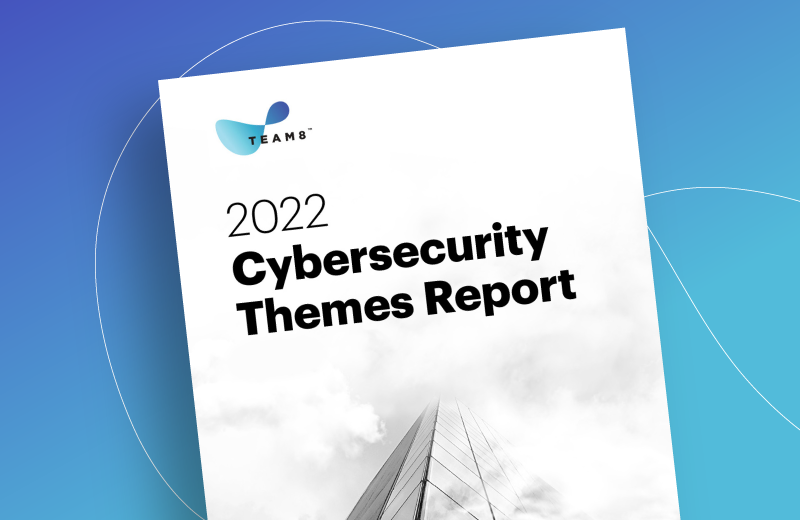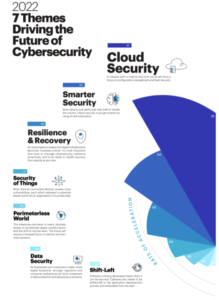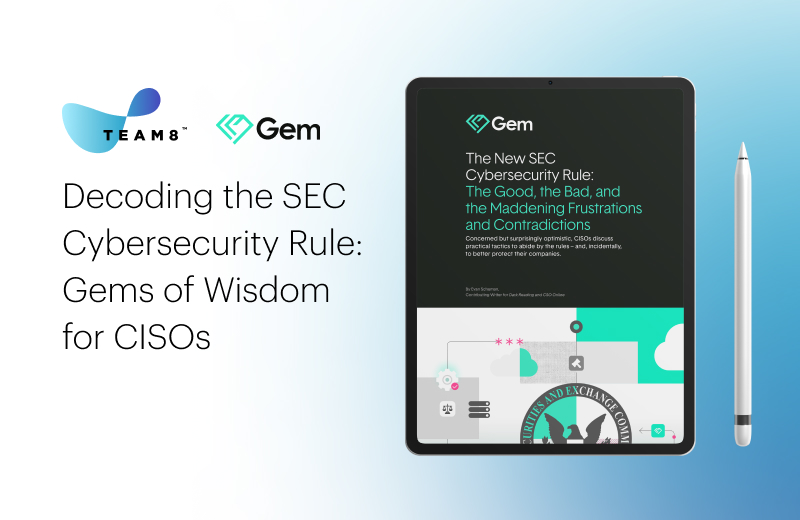The 7 Themes Shaping the Future of Cybersecurity: Introducing Team8’s 2022 Cybersecurity Themes Report

[Click here to download the full report]
In 2021, we continued to see huge changes in IT and cybersecurity, partly as a result of the COVID-19 pandemic. These changes included a continued expansion in remote work, accelerated digital transformation, an increase in cloud adoption, transformations in healthcare, and more. It’s incredible just how much of the world became more digital and more connected in such a short timespan. It has been, without a doubt, a year of disruption.
Cyber attackers see disruption as an opportunity. Not only are there more vulnerabilities in our existing infrastructure, but the more humanity moves online and to a more connected reality, the more we also become vulnerable to cyber attacks. In 2021, cybercriminals continued to take advantage of existing and new vulnerabilities, and doubled-down on their exploitation efforts with anything from financial fraud to phishing campaigns to botnets. And on top of this, there was also a tsunami of ransomware, software supply chain attacks, and social media attacks, many of which made major headlines in 2021.
With faster digitization and increased vulnerabilities, there’s now a growing resiliency gap that’s creating a surge in demand for cybersecurity, specifically the need for Smarter Security and increased resilience in order to both protect and mitigate against cyber attacks. If this gap grows too large or too quickly, it could completely erode public trust in our systems. Trust is the cornerstone of digital civilization, and its deterioration could have dramatic consequences on our society and techno-future.
The impact of the pandemic and the increase in remote work
The increased cybersecurity risk of remote work is clear. Research shows that remote work and digital transformation are responsible for a substantial proportion of data breaches. Remote work has also increased the frequency and cost of these breaches. According to IBM’s 2021 Cost of A Data Breach Report, 17.5% of breaches included remote work as a factor, with the cost of a breach increasing by an average of $1.07 million per breach if remote work was a factor. Furthermore, companies with a majority of their workforce working remotely took 58 days longer to detect and contain breaches than those for whom the majority were onsite.1
As the pandemic has driven an increase in remote work and accelerated the use of cloud technologies, opportunities for attackers have also expanded, pushing cybersecurity risk far higher up the corporate agenda. The impact from these major events are being felt in every one of our key cybersecurity trends, and will continue to have a significant effect over the next few years as the emergency, short-term measures put in place in 2020 and 2021 become more embedded, and transform into long-term strategic priorities.
Shift in focus for ransomware
Ransomware is not new – IT and cybersecurity professionals have been talking about it and managing it for over a decade. The big difference today is that these attacks can put whole enterprises, as well as critical infrastructure, at risk. In the past, when ransomware was targeting single computers, it was primarily an issue around data – with attackers threatening to limit access. Then, the move to enterprise-wide ransomware changed the goal of the attacker to be around disruption of operations. This has now created an operational resilience risk that can turn whole companies dark, making it both more high profile and more dangerous.
The Colonial Pipeline attack, in which hackers demanding ransom led the company to shut down its entire oil pipeline, brought the issue into sharp relief. Today, ransomware is a genuine existential risk to the survivability of an enterprise.
High profile attacks are leading to increased government response
In 2021, we saw an increased willingness by governments worldwide to step into cybersecurity in the context of commercial enterprises. The Biden administration highlighted cybersecurity as one of its highest priorities, calling it “a national security and economic security imperative.” President Biden’s Executive Order on Improving the Nation’s Cybersecurity and other recent moves and announcements by the Administration address a range of issues, including that the U.S. government will consider ransomware, even against private companies, as a hostile act against the U.S. government.2 It also announced that attacks against critical infrastructure would be treated as nation-state attacks, and that it can, and will, use government powers to retaliate.
Other countries are also taking this seriously, seen for example in the European Union’s (EU) recent introduction of the Digital Operations Resilience Act (DORA). DORA represents the EU’s efforts to unify third-party risk management among financial institutions.3 Moreover, in November 2021, the UK introduced the Product Security and Telecommunications Infrastructure Bill, which established new cybersecurity requirements for manufacturers and distributors of IoT devices.4
What’s next for cyber
If change continues at the rate it did in 2021, with a corresponding increase in cyberattacks, enterprises and governments could be in trouble. Now is the time to make the world’s technology infrastructure more resilient, including through better automation and improved cybersecurity at the design phase.
As cybersecurity risk continues to move higher up the priority list, inevitably private sector investment has and will continue to increase. This is already evident from recent cyber investment activity in the first half of 2021, which, according to Momentum Partners, shattered all past records, and included 593 M&A and financing transactions equaling $51 billion in deal value. This represents more than a 100% increase from the 293 transactions, and a 250% increase from the $14.5 billion in deal value that was recorded during the first half of 2020.5
Much of this private investment is expected to go into areas influenced by recent events, i.e. areas that digital transformation and remote work have impacted. This includes cloud adoption and digital services, both of which will be important drivers of cybersecurity spending.
Finally, identity is at the heart of digital transformation, and abuse of access is viewed as a common factor in breaches, spurring interest in all areas within identity and access management (IAM).
All of these trends inform our seven cybersecurity themes for 2022. To download the full report, click here.
How we identified our themes
To highlight areas of immense future business growth and product development from a technology, market trends, regulatory, and venture funding standpoint, we engaged with experts and specialists across our Village (350+ C-level executives, many from Fortune 500 or Forbes Global 2000 organizations), the Team8 cybersecurity team, and our range of global advisors.
We also considered Team8’s “Attacker Perspective” (our unique insights into how attackers think and operate), in addition to publicly-available information and research from a range of well-regarded sources. We then cross-referenced our findings with one-on-one interviews with CISOs & cyber defenders, confirming the top areas of acceleration in cybersecurity from the perspective of security leaders.
We considered both mature and nascent markets to gather a broad perspective and track early, emerging technologies that will influence the future and lead to high growth opportunities in the next few years.
Final Thoughts
In the last 18 months, organizations have had to make huge changes, very quickly. Much of this has been in the cloud. This will have major implications for 2022 and beyond.
The huge acceleration in the use of the cloud, and the multiple impacts this has had on work processes, employees, technology policy, and, ultimately, cybersecurity is playing a huge role in the way organizations are considering their technology and cybersecurity requirements. At the same time, the sheer volume and extent of the threats today, accelerated by the pandemic and changing working environments, means that cybersecurity not only has to get better, but it also has to get smarter. Cybersecurity must be implemented in a cohesive, integrated way that reduces complexity and increases efficiency. A driving force will be the use of Smarter Security technologies such as security automation and AI, which are likely to be game changers, and organizations at the forefront of these technologies are already seeing the benefits.
Resilience is also key. Cyber attacks are a fact and no security posture is likely to be able to eradicate them completely. Accordingly, ensuring that there are sufficient backups and resiliency measures in place reduces the impact and cost of successful attacks, and speeds up recovery time. It also reduces the likelihood of business-wide interruptions.
Finally, this is all having a huge impact on the role of the CISO because cybersecurity cannot, and should not, stand alone. CISOs and cybersecurity teams should be core to the business, and they should be working up, down, and sideways in order to take a strategic approach to the intersection of technology, security, and business operations.
Going forward, cybersecurity will be critical to any digital transformation strategy, and smart technology choices, including cybersecurity considerations, must be integrated into both the technology stack and the business from the start.
Download the full report for more details on the seven themes driving the future of cybersecurity in 2022.
References
- IBM Cost of a Data Breach Report 2021. (2021). IBM Security and the Ponemon Institute. https://www.ibm.com/security/data-breach
- Biden, J. (2021). Executive Order on Improving the Nation’s Cybersecurity. The White House. https://www.whitehouse.gov/briefing-room/presidential-actions/2021/05/12/executive-order-on-improving-the-nations-cybersecurity/
- Proposal on Digital Operational Resilience for the Financial Sector. (2020). European Commision. https://ec.europa.eu/transparency/documents-register/detail?ref=COM(2020)595&lang=en
- Dorries, N. (2021). Product Security and Telecommunications Infrastructure Bill. UK Parliament, Department for Digital, Culture, Media and Sport. https://bills.parliament.uk/bills/3069
- Cybersecurity Market Review 1H 2021. (2021). Momentum Partners. https://momentumcyber.com/cybersecurity-market-review-h1-2021/
- Oracle 2021 Cloud Security Trends. (2021). Oracle. https://www.oracle.com/a/ocom/docs/top-5-cloud-security-trends-for-2021.pdf
- 2021 Cloud Security Report. (2021). Fortinet & Cybersecurity Insiders. https://www.fortinet.com/resources-campaign/dynamic-cloud-security/2021-cloud-security-report?utm_source=blog&utm_campaign=2021-cloud-security-report
- The State of SaaS Sprawl in 2021. (2021). Productiv. https://productiv.com/resources/the-state-of-saas-sprawl-in-2021/
- Croll, T. & Heiser, J. (2021). Hype Cycle for Cloud Security, 2021. Gartner. https://www.gartner.com/en/documents/4004061/hype-cycle-for-cloud-security-2021
- (ISC)2 Cybersecurity Workforce Study, 2021. (2021). (ISC)2. https://www.isc2.org/-/media/ISC2/Research/2021/ISC2-Cybersecurity-Workforce-Study-2021.ashx
- Feiner, L. (2021). Microsoft Announces Plan to Cut Cybersecurity Workforce Shortage in Half by 2025. CNBC. https://www.cnbc.com/2021/10/28/microsoft-aims-to-cut-cybersecurity-workforce-shortage-in-half-by-2025.html
- Preparing for AI-enabled Cyberattacks. (2021). MIT Technology Review Insights. https://www.technologyreview.com/2021/04/08/1021696/preparing-for-ai-enabled-cyberattacks/
- The State of Ransomware 2021. (2021). Sophos. https://www.sophos.com/en-us/medialibrary/pdfs/whitepaper/sophos-state-of-ransomware-2021-wp.pdf?cmp=120469
- 2021 Data Breach Investigations Report. (2021). Verizon. https://www.verizon.com/business/resources/reports/dbir/
- Attacks From All Angles: 2021 Midyear Cyber Report. (2021). Trend Micro. https://www.trendmicro.com/vinfo/us/security/research-and-analysis/threat-reports/roundup/attacks-from-all-angles-2021-midyear-security-roundup
- Updated Advisory on Potential Sanctions Risks for Facilitating Ransomware Payments. (2021). U.S. Department of the Treasury’s Office of Foreign Assets Control (OFAC). https://home.treasury.gov/system/files/126/ofac_ransomware_advisory.pdf
- The State of Ransomware 2020. (2020). Sophos. https://www.sophos.com/en-us/medialibrary/Gated-Assets/white-papers/sophos-the-state-of-ransomware-2020-wp.pdf
- Ransomware: The True Cost of Business. (2021). Cybereason. https://www.cybereason.com/hubfs/dam/collateral/ebooks/Cybereason_Ransomware_Research_2021.pdf
- Balmforth, T. & Tsvetkova, M. (2022). Russia Takes Down REvil Hacking Group at U.S. Request – FSB. Reuters. https://www.reuters.com/technology/russia-arrests-dismantles-revil-hacking-group-us-request-report-2022-01-14/
- Janardhan, S. (2021). More Details About the October 4th Outage. Meta. https://engineering.fb.com/2021/10/05/networking-traffic/outage-details/
- Summary of the AWS Service Event in the Northern Virginia (US-EAST-1) Region. (2021). AWS. https://aws.amazon.com/message/12721/
- Rozeman, J. & Hoeck, M. (2021). Innovation Insight for Leveraging Isolated Recovery Environments and Immutable Data Vaults. Gartner. https://www.gartner.com/en/documents/4002031/innovation-insight-for-leveraging-isolated-recovery-envi
- Blair, R. & Hewitt, J. (2021). Market Guide for Disaster Recovery as a Service. Gartner.
- Hojlo, J. (2021). Future of Industry Ecosystems: Shared Data and Insights. IDC. https://blogs.idc.com/2021/01/06/future-of-industry-ecosystems-shared-data-and-insights/
- The Connected Enterprise: IoT Security Report 2021. (2021). Palo Alto Networks & Vanson Bourne. https://www.paloaltonetworks.com/apps/pan/public/downloadResource?pagePath=/content/pan/en_US/resources/research/connected-enterprise-iot-security-report-2021





